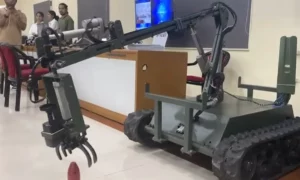The Indian Army’s top officials are currently exploring the utilization of artificial intelligence (AI) to enhance “mobility and protection,” as revealed by Army Chief General Manoj Pande during NDTV’s inaugural Defence Summit. Pande mentioned that ongoing AI projects include natural language processing, facial recognition, vehicle tracking, satellite imagery analysis, and other autonomous systems.
Furthermore, Pande highlighted that the Indian Army, with the assistance of subject matter experts, is devising an AI roadmap expected to be beneficial for the next 20 to 25 years. This roadmap encompasses various initiatives such as the development of robotic surveillance platforms, autonomous combat vehicles, and manned-unmanned cleaning solutions. Additionally, a tri-services project aimed at creating a high-powered computing AI cloud is underway. The Indian Army is also exploring the potential of 5G communications for training and operational purposes.
Pande emphasized the enhancement of battlefield situational awareness through border surveillance systems, a diverse range of surveillance drones for target acquisition, and precision fires. The Army has also introduced swarm drones and new artillery platforms. Night fighting capabilities have been bolstered through the integration of night sights for small arms and handheld thermal imaging devices. Moreover, communication capabilities, down to the soldier level, are being upgraded through the induction of software-defined radios. Terrain-specific electronic warfare systems, drone, and anti-drone systems are being deployed to further enhance effectiveness. Additionally, logistic capacities and efficiencies are being augmented through the introduction of logistic drones.
While expressing optimism about modern technology, Pande acknowledged the challenges associated with the modernization and replacement of vintage platforms all at once. He stated that such an approach is neither feasible nor desirable. Instead, the Indian Army aims to substantially increase the ratio of state-of-the-art equipment to vintage platforms by 2030 through a focused “atmanirbhar” (self-reliant) capability development roadmap.
Beyond India, the United States Army Laboratory is also delving into AI experimentation. They are evaluating the potential of OpenAI’s generative AI solution in battle planning, albeit within the context of a military video game.
In conclusion, the Indian Army’s foray into AI technology signifies a proactive approach to leverage modern advancements for enhancing operational capabilities. Through strategic planning and collaboration with experts, the Army is poised to integrate AI solutions across various domains, thereby bolstering its effectiveness and preparedness for future challenges. Similarly, international counterparts like the US Army are also exploring innovative applications of AI in military operations, showcasing the global trend towards leveraging cutting-edge technology for defense purposes.










